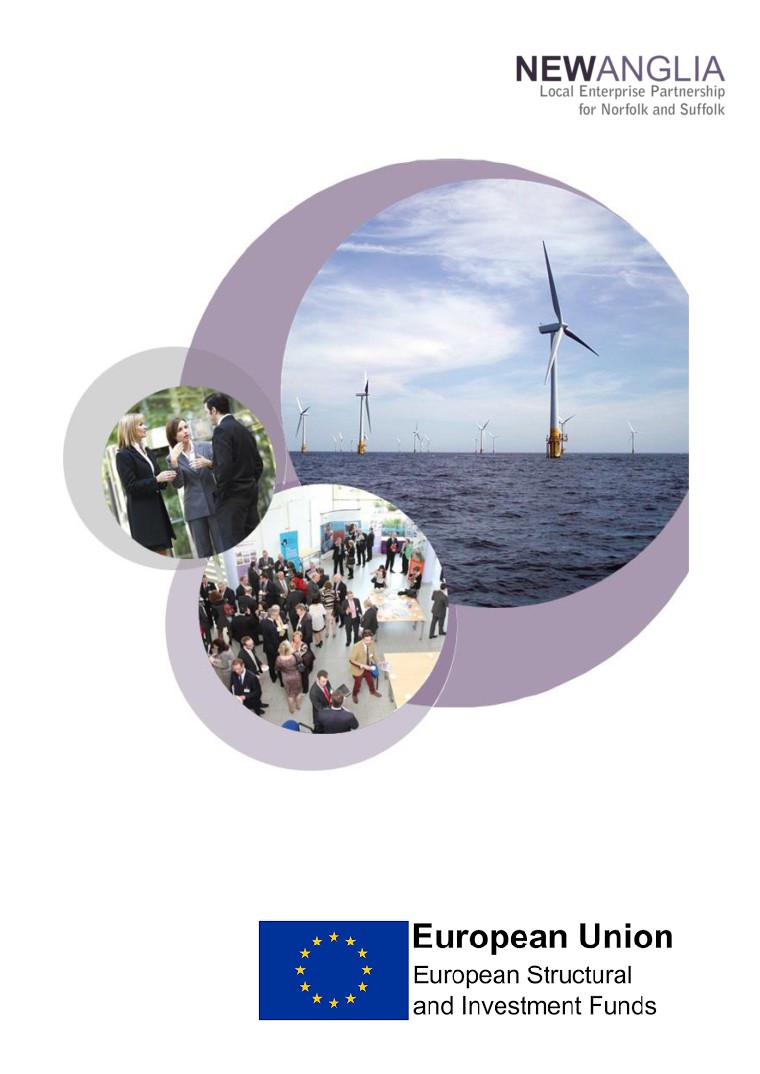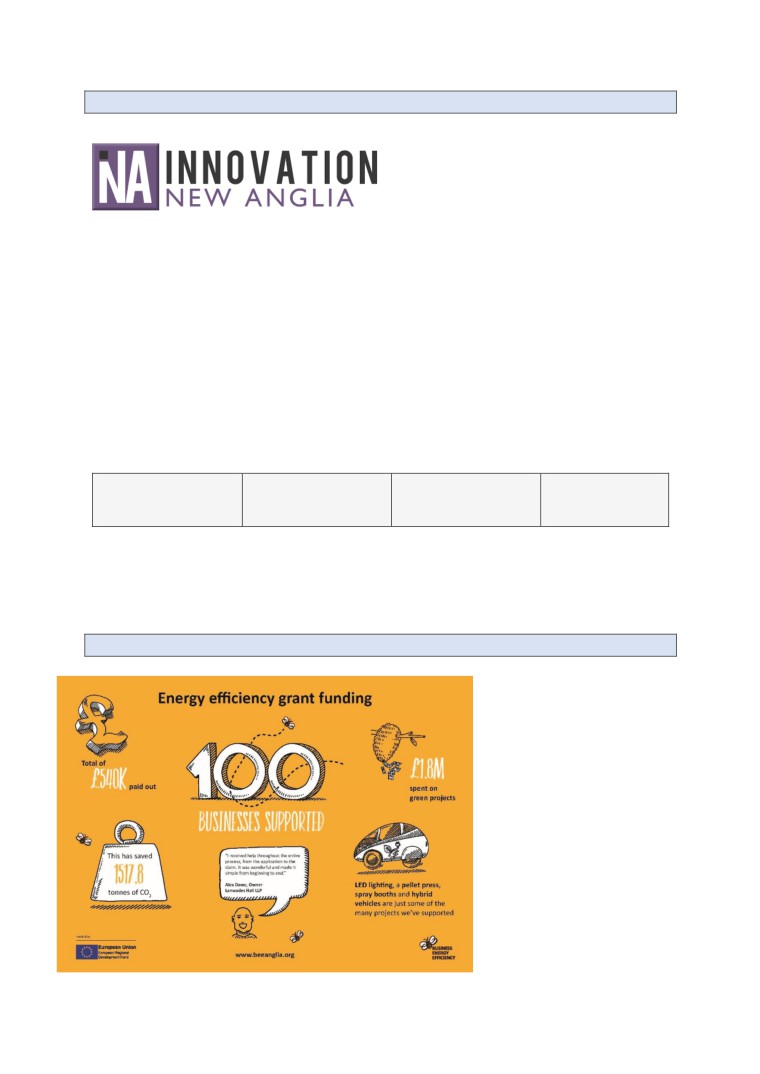European Investment Strategy: Update November 2019
Contents
Introduction
3
European Investment Strategy and ESIF Committee
3
Strategy Update
3
Strategic context
4
Alignment with the Norfolk and Suffolk Economic Strategy
4
Local Industrial Strategy
6
Progress so far
8
European Investment Strategy - Programme Priorities
9
Norfolk and Suffolk Economic Strategy data sets
9
Headline Programme Targets
9
European Social Fund
11
Programme priorities
11
Sector Skills Deals and Youth Pledge
11
Calls for Projects
11
Funding allocations and technical assistance
11
Norfolk and Suffolk Economic Strategy priorities for ESF delivery
12
Specific ESF Priorities and Calls
14
European Regional Development Fund
25
Programme priorities
25
Calls for Projects
26
Low Carbon Financial Instrument
26
National Reserve Fund opportunity
26
Funding allocations and technical assistance
26
Role of the Growth Hub
26
ERDF Changes to investment priorities
26
Norfolk and Suffolk Economic Strategy priorities for ERDF delivery
27
Specific ERDF priorities and calls
33
European Agricultural Fund for Rural Development
43
Programme priorities
43
Norfolk and Suffolk Economic Strategy priorities for EAFRD delivery
43
Annex
46
2
Introduction
In the 2014-20 EU Funding Programme period, New Anglia LEP has an allocation of
over £86m to invest in business growth and skills across our economy, administered
directly by Government departments with LEP input on strategic fit.
European Structural and Investment Funds (ESIF)
New Anglia
Fund
Purpose
Administration
allocation
European Regional
SME
Ministry for
£43.6m
Development Fund
competitiveness,
Housing,
(ERDF)
innovation and the
Communities and
low carbon economy.
Local Government
European Social
Employability,
Department for
£39.82m
Fund (ESF)
training and skills
Work and
Pensions
European
Rural business
Department for
£13.01m
Agricultural Fund
growth
Food and Rural
for Rural
Affairs
Development
(EAFRD)
Total ESIF Funds
£86.43m
European Investment Strategy and ESIF Committee
New Anglia LEP area has a European Structural and Investment Funds (ESIF)
Committee which determines applications to the Programme against local Strategic
fit, and which was responsible for the development of the original European
Investment Strategy in 2014, updated in 2016, and March 2019.
Strategy Update
This European Investment Strategy Update provides a snapshot of Programme
progress to date, setting the ESIF Programme priorities in the context of the Norfolk
and Suffolk Economic Strategy.
The Treasury Guarantee agreed in 2018 means that the ERDF and ESF
Programmes will run to 2020 with spend to 2023 as originally planned. The EAFRD
rural Programme will see a further National Reserve Fund Call in 2019-20 to contract
a final cohort of projects.
The priorities set out in this document are aligned to the Norfolk and Suffolk
Economic Strategy and Local Industrial Strategy. They are also relevant even if there
are changes in the administration of the Programme or in the wider economic
climate.
3
Strategic context
The New Anglia European Investment Strategy is part of a set of strategic
documents which provide a framework for the delivery of the Norfolk and Suffolk
Economic Strategy.
The Economic Strategy Delivery Plan sets out the principal interventions proposed
by the LEP and key partners to achieve the ambitions and goals set out in the
Economic Strategy. A new Funding Framework and Investment Plan will be
developed during 2019/20 to help focus on funding opportunities that will deliver the
biggest gains for delivery. This will be accompanied by an Investment Plan, a live
document which sets out interventions for which some will require significant funding
will be sought. The LEP ESIF Strategy sits alongside this Investment Plan providing
the strategic basis for allocating the significant sums available through the ESIF
funds.
Any new applicants to the Programme will be expected to test their proposals
against the priorities in this Strategy, but it will also provide a useful tool for projects
already up and running to measure their performance against Economic Strategy
priorities and ambitions, and for the LEP to assess the impact of the Programme on
completion.
Alignment with the Norfolk and Suffolk Economic Strategy
The programme targets in this European Investment Strategy have clear alignment
with the headline ambitions of the Norfolk and Economic Strategy and its Priority
themes.
Norfolk and Suffolk
Economic Strategy
ESIF Programme links
Ambitions
ERDF Priority 3 SME competitiveness seeks to fund
projects which deliver high growth.
The place where high
Success to date: the New Anglia Business Growth
growth businesses with
Programme has been prioritising investment and support
aspirations choose to be
to high growth firms. It has supported over
1,000
businesses to date.
ERDF Priority
3 SME competitiveness will fund
An international facing
business support programmes which provide specialist
economy with high value
export advice.
exports
Success to date: Get Exporting 2 is a multi-LEP project
delivering export support. It has worked with
79
businesses in New Anglia during that period.
ERDF Priority 1 innovation supports projects which
help businesses to innovate, ERDF Priority 3 SME
A high performing,
competitiveness supports projects which work with
productive economy
businesses to develop and improve their business model
and to invest in their growth. ESF Priority 2 supports
4
project which provides the training and skills support to
improve workforce skills and productivity.
Success to date: over 770 jobs have been created as a
direct result of ERDF investment so far in this
programme, over
600 new businesses have been
supported to start up and almost 40 new products have
come to market.
Both ERDF Priority 1 innovation and ERDF Priority 3
SME competitiveness encourage projects to develop
clusters, knowledge networks and ERDF Priority
1
innovation actively seeks projects which deliver
knowledge transfer between specialist institutions and
SMEs. New Anglia LEP works with other LEPs to share
A well connected place
good practice and knowledge across projects.
Success to date: The Transport and Logistical
Efficiencies (TALE) project is funded by ERDF Priority 3
SME competitiveness to work with businesses in the
logistics sector to improve efficiency, Keep+ is a multi-
LEP project funded through ERDF Priority 1 innovation to
connect university expertise with business need.
ESF Priority 1 supports projects which help unemployed
and inactive people back into work. ESF Priority 2
supports businesses to up-skill employees and also
An inclusive economy with
supports projects which bring businesses and skills
a highly skilled workforce
providers closer together in collaboration.
Success to date: Over £38m ESF funding committed to
date delivering to over 14,000 participants.
Both ERDF Priority 1 innovation and ERDF Priority 3
SME competitiveness encourage targeted support to
key sectors. ERDF Priority 4 low carbon economy
supports projects which reduce carbon emissions and
A centre for the UK’s clean
deliver low carbon innovation.
energy sector
Success to date: BEE Anglia has supported
100
businesses with clean energy actions to date and
Innovation New Anglia has invested in 21 collaborations
between business and the academic sector, building a
cleantech network of businesses.
New Anglia LEP is keen to ensure that its ESIF allocation
is spent on high quality projects which deliver growth and
A place with a clear,
improved skills, and develop an excellent investment
ambitious offer to the
offer in Norfolk and Suffolk.
world
Success to date: Invest East is a new project seeking to
generate significant investment into the Norfolk and
Suffolk business community.
5
Local Industrial Strategy
The Government has asked all parts of England to develop a Local Industrial
Strategy. The draft Norfolk and Suffolk Local Industrial Strategy has been compiled
in consultation with a wide range of local stakeholders and adopted locally by the
LEP Board and endorsed by all Local Authorities. It reflects a broad consensus on
the strengths of the Norfolk and Suffolk economy and the strategic economic
opportunities we want to build on.
The Local Industrial Strategy is the next stage in the evolution and implementation of
Norfolk and Suffolk Economic Strategy. It looks in more detail at our competitive
strengths and high growth sectors, focussing on what makes our region stand out
against the rest of the UK and identifies key interventions to help drive clean growth.
It sets out a vision for Norfolk and Suffolk as the UK’s clean growth region, supported
by our underpinning sectors. Norfolk and Suffolk seek to play a major role in the
UK’s transition to a post carbon economy and to continue at the forefront of tackling
the challenges and opportunities of climate change. To support this aspiration,
we would like to enable local projects to seek support under Priority 5
Promoting Climate Change Adaptation and Risk Management, and Priority 6
Resource Efficiency under the National Reserve Fund opportunity.
As the Local Industrial Strategy highlights, Norfolk and Suffolk have a significant
issue with water shortage, which hampers sustainable growth, especially in the
agrifood sector. There is also a growing commitment to soil sustainability and
increasing and maintaining biodiversity, reflected in our clean growth planning, which
also provides opportunities to our digital and clean energy sectors.
Future investment under Priority axis 6 would enable the delivery of these priorities.
Investment under priority axis 5 would enable the best possible land management for
the mitigation of climate change, as well as supporting the protection of homes and
key economic assets at risk of flooding, especially in our coastal towns. Investment
under priority 2 could also support our wider digital infrastructure and enable us to
deliver our ambitions for this key sector.
The following tables highlight some of the links between Local Industrial Strategy
priorities and ERDF priority axes, but are not intended to be comprehensive.
Norfolk and Suffolk
European Investment
Local Industrial Strategy -
Strategy Programme
key opportunities
Priorities
Clean Energy - powering the world
Norfolk and Suffolk is well placed to be a global exemplar for
ERDF Priority 1 innovation
clean, low carbon energy production, exporting services and
skills globally, whilst increasing the availability of affordable
ERDF priority 4 Low Carbon
sustainable energy for local communities and businesses.
Economy
6
Agri-food - feeding the world
Norfolk and Suffolk has the innovation and expertise to
ERDF Priority 1 innovation
develop, pioneer and apply new approaches to sustainable
agriculture, utilising clean energy and innovative water
ERDF priority 6 - preserving
management, and increase value added processing and
and protecting the
exports through the applications of new technologies and
Environment and Promoting
systems.
Resource Efficiency
Information and Communications Technology
ERDF Priority 1 innovation
and Digital Creative- connecting the world
Grow and secure the information and communications
ERDF priority 2 access to and
technology and digital creative clusters at Adastral Park and
quality of ICT
Norwich as national assets. Build the integrated networks that
business need including the UK’s first advanced highspeed
ERDF priority 4 Low Carbon
optical wireless network.
Economy
Industrial Strategy
Norfolk and Suffolk
European Investment
Foundations of
Economic Strategy
Strategy Programme
Productivity
Priority Themes
Priorities
Competitive Clusters
ERDF Priority 1 innovation
close to Global
Ideas
Centres
ERDF priority 4 Low Carbon
The world’s most innovative
Economy
economy
Collaborating to Grow
ESF Priority 1 and 2 Inclusive
Labour Markets and Skills for
Growth
People
Driving Inclusion and
Good jobs and greater
Skills
ERDF all priorities
earning power for all
EAFRD - investment leading
to the creation of quality jobs
Targeted infrastructure
Priority axis 6 promoting
development supports delivery
resource efficiency (especially
Infrastructure
of all priority themes
in relation to water and land
A major upgrade to the UK’s
resources)
infrastructure
Priority 2 Access to, and
quality of, ICT.
Our Offer to the World
Business environment
ERDF Priority 3 SME
The best place to start and
Driving Business
competitiveness
grow a business
Growth and
Productivity
Places
Priority axis 5 Promoting
Prosperous communities
Relevant to all priority themes
Climate Change adaptation
across the UK
and places
and risk management
7
Progress so far
European Regional Development Fund
Headline achievements in New Anglia since 2015
£26m contracted in 13 projects, almost
Over 4,800 businesses due to receive
60% of the programme total, with a
support, more than double the
further £10m in the application process
programme target of 2,325.
Target for businesses supported 84%
More than 275 businesses have
achieved already with more than 1,967
received direct grants from ERDF-
businesses supported with specialist
funded Programmes, 22% of the target.
advice and/or grants.
38 new to the market products
608 start-ups have been supported
developed thanks to ERDF funding,
to establish and grow,
over 63% of the target of 60.
92% of the 657 target.
771 jobs created as a result of ERDF
2370 businesses receiving specialist
investment in businesses, 119% of the
information and diagnostics, almost
target of 647 jobs.
20 times exceeding the target of 119.
European Social Fund
Headline achievements in New Anglia since 2015
£31m contracted with 17
Over 14,522 individuals
30% of unemployed
projects
due to receive
participants receiving
employability or training
employability support
support
predicted to find work as
a result
European Agricultural Fund for Rural Development
Headline figures to end 2018
Programme fully
16 food processing
27 business development
committed with over
projects approved or
projects including
£13m awarded to projects
contracted including 4
investment in tourism,
or in the application
projects with around £1m
brewing and rapeseed oil
process
investment
production
8
European Investment Strategy - Programme Priorities
The following pages set out the following elements for each of the three ESIF
Programmes - European Regional Development Fund (ERDF), European Social
Fund (ESF) and European Agricultural Fund for Rural Development (EAFRD):
• Key Programme priorities linked to the Norfolk and Suffolk Economic Strategy
and Local Industrial Strategy.
• Programme-specific information about Calls for projects or ESIF targets
• Aspirations for programme delivery set against Norfolk and Suffolk Economic
Strategy high level objectives
• National and local objectives against each priority within each programme and
New Anglia LEP official targets for those objectives
Norfolk and Suffolk Economic Strategy data sets
The development of the Economic Strategy was supported by the collation of a
substantial dataset, which applicants to all programmes should use to inform project
development and post-project evaluation.
Headline Programme Targets
These are some of the key targets at Programme level which New Anglia will be
using to determine progress and delivery against this Strategy and against the
Norfolk and Suffolk Economic Strategy. Each target is broken down by sub-priority
in the sections which follow. This table also indicates where ESIF Programme
targets correlate directly with Norfolk and Suffolk Indicators used to measure delivery
of the Norfolk and Suffolk Economic Strategy.
Target
Target
Programme
Performance
%
Economic
reference
Target
to end 2018
achieved
Strategy
(processed
Indicator
claims)
European Regional Development Fund
CO01
Number of
enterprises
2325
1967
84%
receiving
support
CO02
Number of
enterprises
1247
275
22%
receiving
grants
9
CO05
Number of
Businesses
new
657
608
92%
- 2%
enterprises
annual
supported
growth
CO08
Employment
Jobs -
increase in
647
771
119%
0.5%
supported
annual
enterprises
growth
CO28
Number of
60
38
63%
enterprises
supported to
introduce new
to the market
products
P13
Number of
enterprises
119
2370
1991%
receiving
information,
diagnostic and
brokerage
European Social Fund
01
Number of
participants
28,110
R1
Number of
participants in
1659
priority 1 into
employment
R7
Number of
Skills,
participants
1489
increase in
receiving
NVQ3+ by
training
1.4% over 5
achieving level
years
3 or above
European Agricultural Fund for Rural Development
Jobs created
Jobs -
as a result of
130
0.5%
investment
annual
growth
The results to date for the ESF and EAFRD programmes are not available at LEP
level. We will be working with the Programmes and successful projects to collate
this data on a regular basis.
10
European Social Fund
Programme priorities
One of the five priority themes in the Norfolk and Suffolk Economic Strategy is
Driving Inclusion and Skills. The Norfolk and Suffolk aspiration is that -
Our people, whether in traditional careers, micro businesses, arts and culture or
supporting others in the community, are central to all our ambitions and goals. We
want to raise and support aspiration across all ages. Good progress has been made
in raising skill levels, but we want to go further and faster, particularly for those
already in work. We will help our young people set their ambitions high and
understand the exciting local careers available to them.
There are a number of high-level objectives under this theme which provide the
focus for interventions in the Economic Strategy Delivery Plan. ESF-funded projects
to date have contributed to the delivery of a number of these objectives as detailed
below and we would expect any future projects to deliver against at least one of
these objectives. Suggestions for possible future activity are also outlined.
Sector Skills Deals and Youth Pledge
A key driver of Norfolk and Suffolk skills activity is the Sector Skills Deals, developed
with ESF funding, and now providing the starting point for focused skills activity
tailored to the needs of our key sectors. The New Anglia Youth Pledge is also a
focus for our aspiration to ensure that all young people are given a good start to their
careers.
Calls for Projects
ESF operates through targeted Calls for projects. The Calls to date in Norfolk and
Suffolk are listed in the Priority sections below. All Call documents are approved by
the LEP ESIF sub-Committee, which includes specialists from the skills and
employability sector.
There is still some scope for additional local Calls in Priority 2. Later in 2019, there
are likely to be national Calls for projects. This Strategy Update will help the New
Anglia ESIF Committee to test the strategic impact of any New Anglia projects put
forward nationally.
Funding allocations and technical assistance
The funding allocated to the New Anglia LEP area is in euros, and therefore the
amount in £ can change. The ESF Programme was revalued in 2018 and the figures
in this document are all up to date at February 2019
New Anglia LEP has worked closely with colleagues in Norfolk County Council and
Suffolk County Council to deliver Technical Assistance projects in ERDF and ESF
which support potential applicants through the funding process and promote the
Programmes.
11
Norfolk and Suffolk Economic Strategy priorities for ESF delivery
Theme: Driving Inclusion
ESIF delivery to date and future
ESF
and Skills
direction
Priority
High Level Objective:
Sector Skills Plans received £300,000
(DIS1):
funding under Priority 2.1 and the
2
completed plans are published here.
Through the development of
sector skills plans produce
The New Anglia LEP Skills Board and
clear statements about the
Sector Working Groups are working on
skills businesses need now
the delivery of the Plans.
and in the future, to
Future projects may address
influence providers,
challenges identified in the sector
business investment and
skills plans.
personal choices by new
students and those already
in the workforce.
High Level Objective:
(DIS2):
Skills training for businesses in the ESF
2
Develop an integrated skills
programme have been concentrated in a
offer for businesses across
small number of high impact projects to
Norfolk and Suffolk, to make
date, and have included a wide range of
it easier for them to navigate
training options, including technical skills.
and access the initiatives
and providers that are
available. We will focus
Future projects may focus on the
particularly on long term
technical skills gaps identified in
development of technical
sector skills plans, and should also
skills in our existing
work towards an ‘integrated skills
workforce.
offer’ with other initiatives.
High Level Objective:
(DIS3):
While the ESF Programme does not fund
2
Prioritise capital investment
capital interventions, the LEP Funds
on provision that will deliver
invested in capital interventions in our
the future skills our sectors
colleges have helped support them to
and workforce need. Take a
deliver a range of ESF employability and
commissioning approach
training activity in the ESF Programme to
and being clear about what
date.
must be provided. We will
Skills Deal funding has been used to
use the Skills Deal
match fund ESF investment and has
programme to drive
included a major work trials project for
innovation aligned to local
young people leaving care.
economic need.
Future projects may be generated by
the sector skills plans or sector
groups, and may align capital
12
investment with new programme
delivery which meets our priorities.
High Level Objective:
(DIS4):
The College of West Anglia has run a
2
Skills Support for Emerging Leaders
Prioritise leadership support
programme with £375,000 ESF funding,
for our entrepreneurs and
and through the ESF -funded LIFT
those in new high growth
Programme, Hethel Innovation are
businesses, through further
offering a start-up advice programme to
accelerator support and
budding entrepreneurs.
business mentorship. We
will provide the ecosystem
Future projects may consider how to
that new entrepreneurs
nurture the skills needed for
need to succeed.
successful entrepreneurship.
High Level Objective:
(DIS5):
There have been two ESF Calls
1
specifically requesting projects
Deliver the Youth Pledge for
addressing the Youth Pledge, one under
all our young people,
investment priority 1.2 seeking
providing an integrated offer
programmes of support from providers
that shows and inspires
and the other under 2.2 to develop better
them about the
links with businesses committed to the
opportunities that exist and
Youth Pledge.
provides support to enable
them to access them,
Two major multi-partner ESF projects -
including support into
run by the Matthew Project and
employment.
Community Action Suffolk respectively -
have also provided a significant package
of support for young people facing
barriers to employment.
Future projects will consider what
further interventions are needed in
addition to existing provision, and will
ensure a good fit with other services.
High Level Objective:
(DIS6):
ESF is supporting a number of projects to
2
create new apprenticeships and there have
Step up our efforts to
been two specific apprenticeship calls under
promote and support the
Priority 2.1 and 2.2.
delivery of high quality
apprenticeships providing
Future projects will consider the existing
clear entry routes into our
landscape of provision in identifying gaps
focus sectors, directly
where intervention will increase the
number and/or quality of apprenticeships.
produce the skills and
capabilities our economy
needs - including higher
level technical skills through
13
degree and higher level
apprenticeships.
High Level Objective:
(DIS10):
ESF has over £18m of support allocated
1
to supporting people into work who face
Develop new approaches
barriers to employment. Projects include
and remove barriers to get
Opportunity Suffolk, which has to date
people back into work,
worked with 535 long-term unemployed
especially for those further
people, 82 of whom have gone into work,
from the job markets and
95 into further training and 36 into active
provide support for all into
job search.
sustained employment
Future projects will review the lessons
learned from current and previous
interventions and identify a clear gap
in provision where further intervention
is needed.
Specific ESF Priorities and Calls
ESF Priority 1 - Inclusive Labour Markets
Funds available
New Anglia ESF Funding Allocation
€21,127,293 (fixed)
£18,380,745*
Investment Priority 1.1: access to
€4,185,130 (fixed)
employment
£3,641,063*
Investment Priority 1.2: sustainable
€4,995,990 (fixed)
integration of young people into the labour
£4,346,511*
market
Investment Priority 1.4: Active inclusion
€11,946,173 (fixed)
£10,393,171*
Total spend (including match funding)
€42,254,586
£36,761,490*
*Based on exchange rate revaluation of the Programme in January 2019.
INDICATORS (by Investment Priority)
ID
Output Indicators
IP 1.1
IP 1.2
IP 1.4
Total
14
O1
Number of Participants
4,120
5,380
9,500
O1 Participants - Male
2,260
2,960
5,220
O1 Participants - Female
1,860
2,420
4,280
O2
Participants (below 25 years of age)
4,990
4,990
who are unemployed or inactive
O2 Participants - Male
2,740
2,740
O2 Participants - Female
2,250
2,250
O4
Participants over 50 years of age
970
1,130
2,100
O5
Participants from ethnic minorities
180
190
240
610
O6
Participants without basic skills
730
880
1,610
CO01
Unemployed, including long-term
3,490
2,830
6,320
unemployed
CO03
Inactive participants
1,030
1,250
2,160
4,440
CO14
Participants who live in a single adult
410
150
560
household with dependent children
CO16
Participants with disabilities
1,060
560
1,370
2,990
ID
Result Indicators
IP 1.1
IP 1.2
IP 1.4
R1
Unemployed participants into employment
22%
14%
(including self -employment) on leaving
R2
Inactive participants into employment, or job
33%
27%
search on leaving
R3
Participants gaining basic skills
4%
4%
R4
Participants with childcare needs receiving
36%
36%
childcare support
R5
Participants (below 25 years of age) in
43%
employment, including self-employment, or
education/training upon leaving
CR02
Participants in education or training on leaving
17%
CR06
Participants in employment, including self-
34%
34%
employment, 6 months after leaving
ESF Priority 1.1 - Current projects and remaining funding opportunities
Access to employment for job seekers and the inactive
National
1.1 Access to employment for job-seekers and inactive people,
priorities
including the long-term unemployment and people far from
the labour market. Also through local employment initiatives
and support for labour mobility.
1.1.1 To improve the employability of long-term
unemployed people, so that they can compete
effectively in the labour market.
1.1.2 To provide individuals from groups which face
particular labour market disadvantage with additional
15
support so that they can compete effectively in the
labour market.
1.1.3 To encourage inactive people to participate in the
labour market and to improve their employability.
1.1.4 To address the basic skills needs of unemployed
and inactive people so they can compete effectively in
the labour market.
1.1.5 To provide support for women at a disadvantage in
the labour market, and particularly those who are
currently inactive, to contribute to our efforts to reduce
the gender employment gap.
Local priorities
In addition to addressing the high-level objectives listed above
and the priorities given in individual Calls, applicants are asked
to consider -
• The needs of employers across the key sectors of the
New Anglia economy and where relevant, skills gaps
identified in the Sector Skills Plans.
• How their projects contribute to the delivery of the New
Anglia Youth Pledge which makes a commitment to
giving young people the support they need to get into
further training or work within 3 months of leaving
education or employment.
• How their proposed provision is aligned with the full range
of other provision locally and how they will reach their
target market. Employability provision can be confusing
for participants, so successful applications will evidence
good partnership working and effective networks in their
delivery model.
• Lessons learned from previous delivery.
• Potential partnerships which could harness the skills of a
range of organisations in a coordinated programme.
Calls and opt-
Grassroots Community Programme - open call
ins to date
Work and Health Integrated Services - open call
Projects
LIFT Jobs, a grassroots
£373,760
contracted to
employability grant scheme
date
for rural initiatives run by
Norfolk County Council.
Projects in the
Three ambitious multi-partner initiatives under the Work and
application
Health Integrated Services Call are in the contracting process.
process
These projects aspire to work across the public and VCSE
sectors to deliver a seamless programme of interventions to
support people with long-term health issues into work. Linked
16
projects are under consideration for those even further from the
workplace under Priority 1.4.
Future
Unlikely to be further Calls under this priority if the projects
opportunities
currently in the pipeline are approved.
ESF Priority 1.2 - Current projects and remaining funding opportunities
Sustainable integration of young people into the labour market
National
1.2 Sustainable integration into the labour market of young
priorities
people, in particular those not in employment, education or
training, including young people at risk of social exclusion
and young people from marginalised communities, through
implementation of the Youth Guarantee.
1.2.1 To support the rise in the participation age by
providing additional traineeship and apprenticeship
opportunities
1.2.2 To engage marginalised 15-18 year olds and
support them to re-engage with education or training
1.2.3 To address the basic skills needs of young
NEETS so that they can compete effectively in the
labour market
1.2.4 To provide additional work experience and pre-
employment training opportunities to unemployed 18-
24 year olds
1.2.5 To support young lone parents to overcome the
barriers they face in participating in the labour market
(inc. childcare)
Local priorities
In addition to addressing the high level objectives listed above
and the priorities given in individual Calls, applicants are asked
to consider -
• The needs of employers across the key sectors of the
New Anglia economy and where relevant, skills gaps
identified in the Sector Skills Plans.
• How their projects contribute to the delivery of the New
Anglia Youth Pledge which makes a commitment to
giving young people the support they need to get into
further training or work within 3 months of leaving
education or employment.
17
• How their proposed provision is aligned with the full range
of other provision locally and how they will reach their
target market. Employability provision can be confusing
for participants, so successful applications will evidence
good partnership working and effective networks in their
delivery model.
• Lessons learned from previous delivery.
• Potential partnerships which could harness the skills of a
range of organisations in a coordinated programme.
Calls and opt-
Greater Ipswich Youth Guarantee - open Call
ins to date
NEET Prevention - ESFA opt-in
Youth Pledge in New Anglia - open Call
Projects
My Go project, delivering a
£1,565,779
contracted to
youth employment service in
date
Ipswich.
Norfolk NEET prevention
£332,721
project led by City College,
Norwich
Projects in the
The Youth Pledge Call closed in February 2019.
application
process
Future
Unlikely to be further Calls under this priority if the projects
opportunities
currently in the pipeline are approved, as Priority 1 is fully
committed.
ESF Priority 1.4 - Current projects and remaining funding opportunities
Active inclusion
National
1.4 Active inclusion, including with a view to promoting equal
priorities
opportunities and active participation, and improving
employability.
1.4.1 To support people with multiple and complex
barriers to participation to address these underlying
issues and to move closer to or into the labour market
1.4.3 To engage marginalised individuals and support
them to re-engage with education, training, or into
employment
Local priorities
• The needs of employers across the key sectors of the
New Anglia economy and where relevant, skills gaps
identified in the Sector Skills Plans.
18
• How their projects contribute to the delivery of the New
Anglia Youth Pledge which makes a commitment to
giving young people the support they need to get into
further training or work within 3 months of leaving
education or employment.
• How their proposed provision is aligned with the full range
of other provision locally and how they will reach their
target market. Employability provision can be confusing
for participants, so successful applications will evidence
good partnership working and effective networks in their
delivery model.
• Lessons learned from previous delivery.
• Potential partnerships which could harness the skills of a
range of organisations in a coordinated programme.
Calls and opt-
• Long term unemployed and young people opt-in
ins to date
opportunities from Building Better Opportunities, the Big
Lottery Fund opt-in Programme.
• Grassroots Community Programme - Open Call
• Work and Health Integrated Services Open Call
• ESFA Opt-in Community Grants programme
Projects
Norfolk Community College, for long-term
£967,100
contracted to
unemployed people in Norfolk, led by
date
East Coast College. BBO opt-in.
Opportunity Suffolk, for long-term
£967,100
unemployed people in Suffolk, led by
TCHC. BBO opt-in.
On Track, for young people in Norfolk, led
£830,450
by the Matthew Project. BBO opt-in.
Minding the Gap, for young people in
£830,450
Suffolk, led by Community Action Suffolk.
BBO opt-in.
£293,904
with people furthest from the labour
market, led by West Suffolk College
Great Yarmouth Inclusion Project, a
£349,746
grassroots project supporting
neighbourhood employability projects in
the Great Yarmouth area and run by
Great Yarmouth Borough Council.
LIFT Community Grants Programme, an
£1,030,292
opt-in 100% grant programme with co-
funding from the ESFA, run by Norfolk
County Council.
Projects in the
Three ambitious multi-partner initiatives under the Work and
application
Health Integrated Services Call are in the contracting process.
process
These projects aspire to work across the public and VCSE
sectors to deliver a seamless programme of interventions to
19
support people with long-term health issues into work. Linked
projects are under consideration for those even further from the
workplace under Priority 1.1.
Future
Unlikely to be further Calls under this priority if the projects
opportunities
currently in the pipeline are approved, as Priority 1 is fully
committed, with high levels of commitment and spend in priority
1.4
ESF Priority 2: Skills for Growth
Funds available
Local ESF Funding Allocation
€24,638,009 (fixed)
£21,435,067*
Investment Priority 2.1: access to
€20,369,175 (fixed)
lifelong learning
£17,721,182*
Investment Priority 2.2: improving
€4,268,833 (fixed)
the labour market relevance of skills
£3,713,885*
provision
Total spend (with match)
€49,276,018
£42,870,134*
*Based on exchange rate revaluation of the Programme in January 2019. New
values of New Anglia funding as confirmed to the ESIF Committee.
INDICATORS (by Investment Priority)
ID
Output Indicator
IP 2.1
IP 2.2
O1
Number of participants
18,610
Participants - Male
9,120
Participants - Female
9,490
O4
Participants over 50 years of age
4,300
O5
Participants from ethnic minorities
810
O6
Participants without basic skills
3,280
CO14
Participants who live in a single adult
730
household with dependent children
CO16
Participants with disabilities
1,400
CO23
Number of supported micro, small and
330
medium-sized enterprises (including
cooperative enterprises and enterprises of
the social economy)
ID
Result Indicator
IP 2.1
IP 2.2
R3
Participants gaining basic skills
11%
R6
Participants gaining level 2 or below or a
25%
unit of a level 2 or below qualification
(excluding basic skills)
20
R7
Participants gaining level 3 or above or a
8%
unit of a level 3 or above qualification
R8
Employed females gaining improved
35%
labour market status
R9
Small and medium enterprises
75%
successfully completing projects (which
increase employer engagement; and/or
the number of people progressing into or
within skills provision)
ESF Priority 2.1 - Current projects and remaining funding opportunities
Skills for Growth: access to lifelong learning
National
2.1 Enhancing equal access to lifelong learning for all age
priorities
groups in formal, non-formal and informal settings, upgrading
the knowledge, skills and competencies of the workforce, and
promoting flexible learning pathways including through career
guidance and validation of acquired competencies
2.1.1 To address the basic skills needs of employed
people, particularly in SMEs and Micro businesses.
2.1.2 To increase the skills levels of employed people
from the existing level to the next level up, to
encourage progression in employment.
2.1.3 To increase the number of people with technical
and job specific skills, particularly at level 3 and
above and into higher and advanced level
apprenticeships, to support business growth.
2.1.4 To increase the skills levels of employed
women to encourage progression in employment to
help address the gender employment and wage gap.
Local priorities
In addition to addressing the high level objectives listed above
and the priorities given in individual Calls, applicants are asked
to consider -
• The priorities identified in the Sector Skills Plans.
• Involving businesses in delivery from the start to ensure
that provision meets their needs.
• Local networks and providing evidence of
understanding of the New Anglia business landscape
which will enable effective promotion and take-up of
new provision.
21
• How their proposed provision is aligned with the full
range of other provision locally and how they will reach
their target market.
• Lessons learned from previous delivery.
Calls and opt-
ESFA opt-in Sector Skills Plans
ins to date
ESFA opt-in Skills Support for the Workforce
ESFA opt-in Skills Support for Emerging Leaders
ESFA opt-in Skills Support for Redundancy
ESFA opt-in Skills Support for Redundancy and the
Workforce (follow on tender)
Grassroots Community Programme - Open Call
In-work pay and progression - health and social care -
Open Call
Local workforce development - Open Call
Apprenticeships Progression - Open Call
Basic Skills in Employment - open Call (no bids
submitted)
Projects
Sector Skills Plans, developed by Skills
£300,000
contracted to
Reach in collaboration with New Anglia
date
LEP, and bringing together skills planning
for key sectors New Anglia
Skills Support for the Workforce run by
£4,999,500
SEETEC, a major programme of workplace
training opportunities.
Skills Support for Emerging Leaders, run
£375,000
by the College of West Anglia, offering
targeted leadership training across New
Anglia.
Skills Support for Redundancy, a
£349,803
programme to help people equip
themselves for a career and job change
after redundancy, run by TCHC
Place 21a, a grassroots training
£293,904
programme run by West Suffolk College
LIFT Skills, a grassroots grant programme
£530,638
funding bespoke training projects for rural
businesses
Projects in the
A Skills in Health and Social Care project is in the contracting
application
process. Applicants to the Local workforce development calls
process
are still in the application process.
A Call for projects under the theme of Apprenticeships
Progression was launched in February 2019 but closed with
no applications and the funds were reallocated.
A combined Priority 2.1 and 2.2 Call for Sector Skills
Development projects closes in December 2019.
22
ESF Priority 2.2 - Current projects and remaining funding opportunities
Skills for Growth: labour market relevance of skills provision
National
2.2 Improving the labour market relevance of education and
priorities
training systems, facilitating the transition from education to
work and strengthening vocational education and training
systems and their quality, including through mechanisms for
skills anticipation, adaptation of curricula and the
establishment and development of work-based learning
systems, including dual learning systems and apprenticeship
schemes.
2.2.1 To promote improvements in the labour market
relevance of skills provision through active
engagement with relevant institutions and
employers, particularly SMEs and Micro businesses.
Local priorities
In addition to addressing the high level objectives listed above
and the priorities given in individual Calls, applicants are asked
to consider -
• The priorities identified in the Sector Skills Plans.
• Involving businesses in delivery from the start to ensure
that provision meets their needs.
• Local networks and providing evidence of
understanding of the New Anglia business landscape
which will enable effective promotion and take-up of
new provision.
• How their projects contribute to the delivery of the New
Anglia Youth Pledge.
• How their proposed provision is aligned with the full
range of other provision locally and how they will reach
their target market.
• Lessons learned from previous delivery.
• Potential partnerships which could harness the skills of
a range of organisations in a coordinated programme.
Calls and opt-
Grassroots Community Programme - Open Call
ins to date
New Anglia Youth Pledge Marque - Open Call
Apprenticeships Support for Employers - Open Call
Projects
Place 21b, engaging employers and young
£293,904
contracted to
people in the development of training
date
provision
23
LIFT Trials, a grassroots rural grant
£530,639
programme for workplace trials projects.
Projects in the
The New Anglia Youth Pledge Marque call closed in February
application
2019 and the Apprenticeships Support for Employers Call
process
closes in May 2019.
A combined Priority 2.1 and 2.2 Call for Sector Skills
Development projects closes in December 2019.
Future
A further Call for a Careers Hub project or projects opened in
opportunities
October 2019.
24
European Regional Development Fund
Programme priorities
As discussed in the Strategic Context section, European Regional Development
Fund priorities align closely to the following Norfolk and Suffolk Economic Strategy
priority themes:
Our Offer to the World
Improving and communicating a clear,
ambitious offer to the world is central to
all our ambitions and targets and to
attracting the people, investors and
businesses of the future
Driving Business Growth and
Our diverse economy is a real strength.
Productivity
Our key businesses and institutions see
well established businesses and supply
chains across our sectors.
Our work to support business will be
driven by three goals:
• Increasing investment.
• Driving productivity.
• Helping our firms move into new
markets and products
Collaborating to Grow
The competition we face does not come
from within Norfolk and Suffolk. Many of
the opportunities we have come from
our proximity to Cambridge and London
as well as global markets. The new
markets and investment opportunities
we seek are national and global.
Competitive Clusters close to global
Within our business sectors, Norfolk
centres
and Suffolk have a number of
recognised national and global clusters
of business, with excellent access to
national and global markets and to
London and Cambridge.
There are a number of high-level objectives under these themes which provide the
focus for interventions in the Economic Strategy Delivery Plan. ERDF-funded
projects to date have contributed to the delivery of a number of these objectives as
detailed below and we would expect any future projects to deliver against at least
one of these objectives. Suggestions for possible future activity are also outlined
here.
25
Calls for Projects
ERDF operates through targeted Calls for projects. The Calls to date in the New
Anglia LEP area are listed in the Priority sections below, and have in the most part
been quite general to encourage the highest possible application rate.
Low Carbon Financial Instrument
In addition, New Anglia LEP in collaboration with the Cambridgeshire and
Peterborough Combined Authority and Hertfordshire LEP has supported the
development of a Low Carbon Financial Instrument under Priority 4. This project
was contracted during 2019 and is run by Norfolk County Council with the University
of East Anglia.
National Reserve Fund opportunity
The final local Calls closed at the end of September 2019. There are further strong
projects under priorities 1, 3 and 4 which may seek further funding when the National
Reserve Fund opens soon. There is also an opportunity to develop initiatives under
other priorities which were not included in the local allocation, but which have a
strong synergy with the aims of the Local Industrial Strategy - an indication of local
priorities to guide applicants under these priorities is set out below.
Funding allocations and technical assistance
The funding allocated to the New Anglia LEP area is in euros, and therefore the
amount in £ can change. The ERDF and ESF Programmes have been revalued in
2018 and the figures in this document are all up to date at February 2019. During
2019, any allocated funding not committed by individual LEPs in these two
programmes will be made available through a competitive national process. This
Strategy Update will help the New Anglia ESIF Committee to test the strategic
impact of any New Anglia projects put forward nationally.
New Anglia LEP has worked closely with colleagues in Norfolk County Council and
Suffolk County Council to deliver Technical Assistance projects in ERDF and ESF
which support potential applicants through the funding process and promote the
Programmes.
Role of the Growth Hub
The LEP has also successfully bid for funding, notably to deliver the Business
Growth Programme. Our Growth Hub plays a key role in raising awareness of the
full range of ERDF, EAFRD and ESF support available to businesses.
ERDF Changes to investment priorities
Priority 1a, which enables capital investment in research infrastructure, was not
included in the original New Anglia ESIF Investment Strategy - the thinking being at
the time that we didn’t want to spend a relatively small ERDF allocation on building
projects, but rather on activity within existing buildings and on joining up innovation
activity across Norfolk and Suffolk.
26
However, it was agreed by the New Anglia LEP ESIF Committee at its November
2018 meeting to include PA1a as an option for investment for the remaining funds for
the following reasons -
• A number of the priorities in the Norfolk and Suffolk Economic Strategy may
require capital investment as part of successful delivery.
• Experience of delivering the current ERDF Programme has shown that
revenue projects generally rely heavily on private sector match funding. It
would be helpful to offer another match funding option in the form of capital
investment to widen the pool of potential applicants.
• PA1 is proving the hardest priority nationally to successfully commit and
spend, and we would like to give potential applicants the widest possible
range of options for the structure of PA1 projects, provided these deliver
against local priorities.
A local Call under the new combined Priority 1a and 1b was issued in 2019.
As indicated above, we would also like to enable local projects to receive funding
under the National Reserve Fund opportunity under priorities 2, 5 and 6 in addition to
the priorities included in the LEP allocation. Local context and priorities for these are
set out below.
Norfolk and Suffolk Economic Strategy priorities for ERDF delivery
Theme: Our Offer to the World
Relevant
Objective
Success to date/ future actions
ERDF
Priority
High Level Objective
Invest East is a partnership project involving
3
(OOW1):
the LEP and local authority partners, with a
Work across all local
£906,000 ERDF grant to develop the
authorities to integrate
investment readiness of Norfolk businesses
our inward investment
and improve our inward investment offer.
and business location
offer, campaigning at
Future projects may consider how to
scale in new markets
support businesses to improve their
and working with
investment potential and development into
national Government.
new markets.
High Level Objective
(OOW5):
SCORE has been supported to deliver
1 or 3
Work with Government
innovation activity in the energy sector.
to ensure that the
unique contribution of
Future projects could consider what
our energy sector is
further activity is needed to support this
sector to grow.
27
well understood and
supported.
High Level Objective
(OOW6):
While ERDF does not support infrastructure
1a
Build the right kind of
projects, it can support the development of
housing and
commercial and innovation premises where
5
commercial space
these lead directly to planned business
where it is needed and
support or innovation activity.
6
integrate utility, road,
rail and green
Future projects may take advantage of the
infrastructure to build
inclusion of Priority 1a in our ERDF
the communities and
innovation offer, and develop research or
places people want to
innovation facilities where there is
live.
evidence of need.
High Level Objective
(OOW7):
Start East has received an ERDF grant of
3
Develop a year-round
£610,000 to deliver bespoke business support
visitor offer by
in the cultural sector in Norfolk and Suffolk.
investing in the
strategic projects such
Future projects may consider how this
as attractions, heritage
support might be continued or enhanced.
and cultural institutions
that also will increase
visitor spend.
Theme: Driving Business Growth & Productivity
Relevant
Objective
Success to date/ future actions
ERDF
Priority
High Level Objective
(DBGP1):
The New Anglia Growth Programme has
3 or 4
Sharpen our high-
received £12.89m for a major programme of
quality business support
business support, including in-depth advice
offer to ensure it meets
and grants.
the changing needs of
businesses adapting to
Future projects will consider the current
new ways of working
support offer, and identify gaps in
and technology. This
particular sectors or types of support
will include leadership
where there is clear evidence of demand
development, and the
for provision.
ecosystem firms need
to share knowledge and
services across sectors.
High Level Objective
(DBGP2):
28
Enable our SMEs to
The Business Growth Programme,
grow and increase
Innovation New Anglia, TALE, and BEE
3 or 4
exports by focusing
Anglia all work with businesses on improving
grant programmes and
growth, efficiency and productivity.
other support on
growth, innovation, and
Future projects will consider lessons
productivity.
learned from previous and current
initiatives and consider how to target
support for the highest possible impact
on growth and productivity.
High Level Objective
Supply chain development is eligible for
3
(DBGP3):
support in the ERDF programme and the
Lead a cross sector
Business Growth Programme works on this
“trade global, supply
as part of their package of support for local
local” campaign, to
businesses.
open up support chain
opportunities for local
Future projects could be developed
businesses.
around supply chain potential and
development.
High Level Objective:
(DBDP4):
ERDF can support aspects of the
3
Prioritise digital and
development of business premises,
physical infrastructure
especially where there is a central hub
2
projects to support
providing support or training to the
businesses to develop
businesses on site.
and provide the space
that new and existing
Future projects may develop a bespoke
firms need to grow.
support service linked to a new business
facility, based on clear evidence of need.
High Level Objective:
(DGBP5):
Keep + and Innovation New Anglia make
1 or 3
Set up new schemes to
links between the university sector and
help high growth
business.
businesses and make it
easier to access advice
Future projects could consider the gaps
and funding for
where interventions to support the
commercial innovation
commercialisation of research could
and commercialising
deliver growth, especially focussed
business and university
around Industrial Strategy key sectors
R&D
Digital ICT, Agritech and Clean Energy.
High Level Objective:
(DGBP6):
The New Anglia Business Growth
3 or 4
Programme aims to provide a clear ‘front
29
Provide improved
door’ to all available support. The proposed
access to finance and
Low Carbon Innovation Fund 2 will if
assist business
successful provide a source of investment
capability in identifying
for relevant early stage companies.
skills deficits. We will
make it easier to access
Future projects will ensure a good fit
these services through
within the support landscape and
a new “front door” for
synergy with the Business Growth
funding support.
Programme, as well as ensuring they
have the expertise to support businesses
to explore finance options.
High Level Objective:
(DGBP7):
This ERDF programme has not to date
1a
Establish new centres
supported capital development, although it
of excellence to
has supported business support and
improve productivity
innovation activity at existing centres of
and innovation
excellence, Hethel Innovation and Orbis.
providing new skills for
business leaders and
Future projects could identify effective
employees.
locations and partnerships to deliver new
centres of excellence where there is a
clear need and demand, a strong support
and innovation offer and access to
relevant expertise.
Theme: Collaborating to Grow
Relevant
Objective
Success to date/ future actions
ERDF
Priority
High Level Objective:
CtC1
Working Across
The New Anglia Business Growth Hub links
3
Sectors
all the business support and innovation
projects in New Anglia, cross referring
Help businesses
where helpful and signposting to the most
collaborate on
appropriate support.
increasingly common
requirements for
Future projects might look at cross-
technical know-how
sector support opportunities and supply
and access to new
chain support
markets and
techniques.
Link up innovation
hubs and wider
business support offer,
30
focusing on specific
places where it makes
sense to do so, for
example in the
opportunities to link up
culture, digital, fin-tech
and creative firms in
Norwich
Build on the success of
our growth hub and
sector groups to help
people and businesses
find the support and
funding needed
Ensure our work on
opening up supply chain
opportunities crosses
sectoral boundaries
High Level Objective:
CtC3
Working with other
Several projects work across several LEP
3 or 1
regions
areas, bringing together partners and
experts across a wide geography. For
Work with other parts
example the Innovation Bridge and Keep +
of the UK on
projects deliver innovation activity across
enhancing supply
several LEP areas.
chains, learning best
practices, influencing
Future projects could consider
government and drive
partnerships and activity across a wide
efficiency around
geography, especially where this drives
procurement,
efficiency, or develops supply chains.
maximising
opportunities for our
firms who are part of
national and global
supply chains and
sectors.
Collaborate with
sector groups and
trade organisations
nationally and
globally, where there
is the opportunity for
our businesses to
work with others to
develop new
opportunities and
markets
31
Theme: Competitive Clusters close to Global Centres
High Level Objective:
CCCGC1
Innovation New Anglia has developed
3 or 1
Develop a
clusters and associated activity for a
commercially led plan
number of sectors. Invest East is
for each cluster that:
supporting the development of investment
opportunities.
Encourages new
companies and
Future projects could develop a package
commercial investment.
of cluster-based activity.
Establishes global and
national links.
Maximises local supply
chain benefits. Markets
the commercial
opportunity. Develops
the ecosystem that
enables the cluster to
thrive
32
Specific ERDF priorities and calls
ERDF Priority 1 : Promoting Research and Innovation
Funding available
Local ERDF Funding Allocation
€12,214,186(fixed)
£11,033,074*
Total spend (with match)
€24,428,372
£22,066,148*
*Based on exchange rate revaluation in January 2019 - €1=£0.87.
INDICATORS (by Investment Priority)
ID
Indicator
IP1a
IP1b
CO01
Number of enterprises receiving support
385
CO02
Number of enterprises receiving grants
258
CO03
Number of enterprises receiving financial
7
support other than grants
CO04
Number of enterprises receiving non-financial
116
support
CO05
Number of new enterprises supported
33
CO06
Private investment matching public support to
€3,261,521
enterprises (grants)
CO07
Private investment matching public support to
€456,552
enterprises (non-grants)
CO08
Employment increase in supported enterprises
37
CO25
Number of researchers employed in improved
6
research facilities
CO26
Number of enterprises cooperating with
253
research institutions
CO28
Number of enterprises supported to introduce
37
new to the market products
CO29
Number of enterprises supported to introduce
74
new to the firm products
P2
Public or commercial buildings built or
200
202
renovated
Current projects and remaining funding opportunities
ERDF Priority 1
Promoting research and innovation
National
1a) enhancing research and innovation (R&I) infrastructure
priorities
and capacities to develop R&I excellence, and promoting
centres of competence, in particular those of European
interest
33
• increase investment in research and innovation
infrastructure that catalyses collaboration with the
research community especially in sectors identified
through smart specialisation
1b) Promoting business investment in R&I:
• developing links and synergies between enterprises,
research and development centres and the Higher
Education sector, in particular promoting investment in
product and service development, technology transfer,
social innovation, eco-innovation, public service
applications, demand stimulation, networking, clusters
and open innovation through smart specialisation;
• supporting technological and applied research, pilot
lines, early product validation actions, advance
manufacturing capabilities and first production, in
particular in key enabling technologies and diffusion of
general purpose technologies.
Local priorities
In addition to addressing the high level objectives listed above
and the priorities given in individual Calls, applicants are asked
to consider -
• How their project will deliver in the priority places
identified in the Norfolk and Suffolk Economic Strategy.
• The needs of key sectors identified in the Norfolk and
Suffolk Economic Strategy and Local Industrial
Strategy.
• Involving businesses in developing project activity and
ensuring clear evidence of need.
• Developing partnerships with a high level of expertise in
innovation and growth and which have the potential to
generate significant impact.
• Local networks and providing evidence of
understanding of the New Anglia business landscape
which will enable effective promotion and take-up of
new provision.
• How their proposed provision is aligned with the full
range of other provision locally and how they will reach
their target market.
• Lessons learned from previous delivery.
Calls and opt-
Regular general calls for innovation projects under priority 1b
ins to date
throughout the Programme to date, and a 2019 Call under
priority 1a and 1b.
34
Projects
Breakthrough, a Hethel Innovation project
£598,176
contracted to
with Cambridge/Norwich Tech Corridor,
date
Norfolk County Council, NUA and UEA
among its partners.
Innovation New Anglia, the precursor of
£528,252
Breakthrough, delivering innovation advice
and network development across key
sectors.
Keep+, an innovation and knowledge
£9,303,112
exchange project across several LEP
areas, with University of Suffolk a delivery
partner.
SCORE, an innovation project for the
£3,000,000
offshore wind sector.
Innovation Bridge, a multi-LEP project
£623,371
providing access to university expertise to
help businesses to grow, with University of
Suffolk a partner.
Projects in the
There is one further projects in the application process, and
application
further applications have been submitted to the final local Call
process
under this priority.
Future
National Reserve Fund.
opportunities
National Reserve Fund opportunity
ERDF Priority 2
Enhancing Access to, and use and Quality Of, ICT.
National
2(a) extending broadband deployment and the roll-out of high-
priorities
speed networks and supporting the adoption of emerging
technologies and networks for the digital economy.
2.(b) developing ICT products and services, ecommerce, and
enhancing demand for ICT
Local priorities
In addition to addressing the high level objectives listed above
and the priorities given in individual Calls, applicants are asked
to consider -
• How their project will support the delivery of clean
growth in Norfolk and Suffolk.
• How their project will deliver in the priority places
identified in the Norfolk and Suffolk Economic Strategy.
• The needs of key sectors and strategic opportunities
identified in the Norfolk and Suffolk Economic Strategy
and Local Industrial Strategy.
• Involving businesses in developing project activity and
ensuring clear evidence of need.
35
• Developing partnerships with a high level of expertise in
innovation and growth and which have the potential to
generate significant impact.
• Local networks and providing evidence of
understanding of the New Anglia business landscape
which will enable effective promotion and take-up of
new provision.
• How their proposed provision is aligned with the full
range of other provision locally and how they will reach
their target market.
• Lessons learned from previous delivery.
Calls and opt-
None in Norfolk and Suffolk. This priority was not included in
ins to date
the New Anglia allocation.
ERDF Priority 3: Enhancing the competitiveness of SMEs
Funding available
Local ERDF Funding Allocation
€22,857,024 (fixed)
£23,164,985*
Total spend (with match)
€45,714,048
£46,329,970*
*Based on exchange rate revaluation of the Programme in January 2019.
INDICATORS (by Investment Priority)
ID
Indicator
IP 3a
IP 3c
IP 3d
Total
CO01
Number of enterprises receiving
298
761
425
1,484
support
CO02
Number of enterprises receiving
196
509
284
989
grants
CO03
Number of enterprises receiving
27
70
40
137
financial support other than
grants
CO04
Number of enterprises receiving
76
198
110
384
non-financial support
CO05
Number of new enterprises
231
239
135
605
supported
CO06
Private investment matching
€1.036m
€3.22m
€1.98m
€6.24m
public support to enterprises
(grants)
CO07
Private investment matching
€33.5k
€1.04m
€663k
€1.74m
public support to enterprises
(non-grants)
36
CO08
Employment increase in
121
312
177
610
supported enterprises
CO28
Number of enterprises
23
23
supported to introduce new to
the market products
CO29
Number of enterprises
119
68
187
supported to introduce new to
the firm products
P2
Public or commercial buildings
37
95
53
185
built or renovated (sq. m)
P11
Number of potential
942
942
entrepreneurs assisted to be
enterprise ready
P13
Number of enterprises receiving
76
43
119
information, diagnostic and
brokerage
Current projects and remaining funding opportunities
ERDF Priority 3
Enhancing the competitiveness of SMEs
National
3a) promoting entrepreneurship, in particular by facilitating the
priorities
economic exploitation of new ideas and fostering the creation
of new firms, including through business incubators.
3c) supporting the creation and the extension of advanced
capacities for products, services and development.
Local priorities
In addition to addressing the high level objectives listed above
and the priorities given in individual Calls, applicants are asked
to consider -
• How their project will deliver in the priority places
identified in the Norfolk and Suffolk Economic Strategy.
• The needs of key sectors identified in the Norfolk and
Suffolk Economic Strategy and Local Industrial
Strategy.
• Involving businesses in developing project activity and
ensuring clear evidence of need.
• Developing partnerships with a high level of expertise in
business support and growth and which have the
potential to generate significant impact.
• Local networks and providing evidence of
understanding of the New Anglia business landscape
which will enable effective promotion and take-up of
new provision.
• How their proposed provision is aligned with the full
range of other provision locally and how they will reach
their target market.
• Lessons learned from previous delivery.
37
Calls and opt-
Regular general calls for Priority 3 projects throughout the
ins to date
programme, with one specific call for Grassroots projects
which has not generated any contracted projects.
Projects
New Anglia Business Growth Programme,
£12,893,947
contracted to
incorporating the New Anglia Growth Hub.
date
Get Exporting 2, an export readiness
£3,925,000
project from Exemplas in collaboration with
the Department for International Trade.
TALE, the Transport and Logistical
£2,874,974
Efficiencies project from Haven Gateway,
works with businesses in the logistics
sector.
£609,769
Anglia, a business support programme for
the cultural sector.
Invest East, a project supporting
£906,910
businesses to explore investment options,
expand and grow.
Better off in Business, a business support
£64,327
programme for young people from the
Princes Trust
Manufacturing Growth Programme, a multi-
£500,000
LEP programme supporting manufacturing
SMEs to grow
Projects in the
Two further projects in the contracting process. Limited
application
funding still available was issued in a final local Call in 2019.
process
Future
National Reserve Fund.
opportunities
ERDF Priority 4 - supporting the shift towards a Low Carbon economy in all
sectors
Funding available
Local ERDF Funding Allocation
€10,475,192 (fixed)
£9,462,000*
Total spend (with match)
€20,950,384
£18,924,000*
*Based on exchange rate revaluation of the Programme in January 2019. New
values of New Anglia funding as confirmed to the ESIF Committee.
INDICATORS (by Investment Priority)
ID
Indicator
IP 4a
IP 4b
IP 4f
Total
CO01
Number of enterprises
27
354
75
456
receiving support
38
CO05
Number of new enterprises
6
13
19
supported
CO26
Number of enterprises
6
6
cooperating with research
institutions
CO29
Number of enterprises
10
10
supported to introduce new
to the firm products
CO30
Additional capacity of
3 MW
3 MW
renewable energy
production
CO34
Estimated annual decrease
2,033
1,726
971
4,730
of GHG (tonnes of CO2
equivalent)
Current projects and remaining funding opportunities
ERDF Priority 4
Supporting the shift towards a Low Carbon economy
National
4a) Promoting the production and distribution of energy derived
priorities
from renewable sources
4b) Promoting energy efficiency and renewable energy use in
enterprises
4f) Promoting research and innovation in, and adoption of, low
carbon technologies.
Local priorities
In addition to addressing the high level objectives listed above
and the priorities given in individual Calls, applicants are asked to
consider -
• How their project will deliver in the priority places identified
in the Norfolk and Suffolk Economic Strategy.
• The needs of key sectors identified in the Norfolk and
Suffolk Economic Strategy and Local Industrial Strategy.
• Involving businesses in developing project activity and
ensuring clear evidence of need.
• Developing partnerships with a high level of expertise in
business support and growth and which have the potential
to generate significant impact.
• Local networks and providing evidence of understanding of
the New Anglia business landscape which will enable
effective promotion and take-up of new provision.
• How their proposed provision is aligned with the full range
of other provision locally and how they will reach their
target market.
• Lessons learned from previous delivery
39
Calls and opt-
Regular general calls during the Programme in addition to the
ins to date
ongoing development of a multi-LEP low carbon financial
instrument with the approval of the LEPs’ ESIF sub-Committees.
Projects
BEE Anglia, a low carbon advice and grant
£2,808,472
contracted to
programme
date
Low Carbon Innovation Fund 2, a financial
£4,300,000
instrument from Norfolk County Council
and the University of East Anglia.
Projects in the
None
application
process
Future
There are no further local calls under this priority.
opportunities
National Reserve Fund opportunity
ERDF Priority 5
Promoting Climate Change Adaptation, Risk Prevention
and Management
National
5b Promoting investment to address specific risks, ensuring
priorities
disaster resilience and developing disaster management
systems
Local priorities
Clean growth is the core vision of the Norfolk and Suffolk Local
Industrial Strategy, and underpins all its objectives. The area
is at the forefront of tackling the challenges and opportunities
of climate change - the area affected earliest by rising sea
levels and changing rainfall pattern and with major research
and business strengths in adapting to the change. Many
businesses are directly threatened by a high level of flood risk,
especially in coastal towns and villages, so managing that risk
effectively will help to secure the economic future of our
coastal communities.
In addition to addressing the high level objectives listed above
and the priorities given in individual Calls, applicants are asked
to consider -
• How their project will support the delivery of clean
growth in Norfolk and Suffolk.
• How their project will deliver in the priority places
identified in the Norfolk and Suffolk Economic Strategy.
• The needs of key sectors and strategic opportunities
identified in the Norfolk and Suffolk Economic Strategy
and Local Industrial Strategy.
• Involving businesses in developing project activity
where relevant and ensuring clear evidence of need.
40
• Developing cross-sector partnerships with a high level
of expertise and which have the potential to generate
significant impact.
• Local networks and providing evidence of
understanding of the New Anglia business landscape
which will enable effective promotion and take-up of
new provision.
• How their proposed provision is aligned with the full
range of other provision locally and how they will reach
their target market.
• Lessons learned from previous delivery.
Calls and opt-
None in Norfolk and Suffolk. This priority was not included in
ins to date
the New Anglia allocation.
National Reserve Fund opportunity
ERDF Priority 6
Preserving and Protecting the Environment and
promoting Resource Efficiency
National
6d - Protecting and restoring biodiversity and soil and
priorities
promoting ecosystems, including through Natura 2000 and
green infrastructure.
6f - promoting innovative technologies to improve
environmental protection and resource efficiency in the waste
sector, water sector and with regard to soil, or to reduce air
pollution
Local priorities
Clean growth is the core vision of the Norfolk and Suffolk Local
Industrial Strategy, and underpins all its objectives. We also
have many businesses directly threatened by a high level of
flood risk, especially in coastal towns and villages, so
managing that risk effectively will help to secure the economic
future of our coastal communities.
In addition to addressing the high level objectives listed above
and the priorities given in individual Calls, applicants are asked
to consider -
• How their project will support the delivery of clean
growth in Norfolk and Suffolk.
• How their project will deliver in the priority places
identified in the Norfolk and Suffolk Economic Strategy.
• The needs of key sectors and strategic opportunities
identified in the Norfolk and Suffolk Economic Strategy
and Local Industrial Strategy.
41
• Involving businesses in developing project activity
where relevant and ensuring clear evidence of need.
• Developing partnerships with a high level of relevant
expertise and which have the potential to generate
significant impact.
• Local networks and engagement.
• How their proposed provision is aligned with the full
range of other provision locally and how they will reach
their target market.
• Lessons learned from previous delivery
Calls and opt-
None in Norfolk and Suffolk. This priority was not included in
ins to date
the New Anglia allocation.
42
European Agricultural Fund for Rural Development
Programme priorities
European Agricultural Fund for Rural Development align most closely to the Norfolk
and Suffolk Economic Strategy priority theme Driving Business Growth and
Productivity. The Norfolk and Suffolk aspiration is that -
Our diverse economy is a real strength. Our key businesses and institutions see well
established businesses and supply chains across our sectors.
Our work to support business will be driven by three goals:
• Increasing investment.
• Driving productivity.
• Helping our firms move into new markets and products
In providing investment in tourism infrastructure projects, this Programme also
supports Our Offer to the World with investment in our tourism offer.
There are a number of high-level objectives under these themes which provide the
focus for interventions in the Economic Strategy Delivery Plan. EAFRD-funded
projects to date have contributed to the delivery of a number of these objectives as
detailed below and we would expect any future projects to deliver against at least
one of these objectives.
As investment is at business level and over 50 projects have been contracted or are
in the pipeline, a summary of the range of investments is given below. A National
Reserve Fund Call is due in 2019, and Norfolk and Suffolk applicants will be
expected to deliver against the priorities below.
Norfolk and Suffolk Economic Strategy priorities for EAFRD delivery
Theme: Our Offer to the World
High Level Objective (OOW7):
Develop a year-round visitor offer by
EAFRD is investing over £3.7m in
investing in the strategic projects such
tourism infrastructure projects, including
as attractions, heritage and cultural
a development at the Museum of East
institutions that also will increase visitor
Anglian Life, a number of footpath
spend.
projects and a Deep History Coast
interpretation project in North Norfolk.
Business development projects
approved include a number of holiday
accommodation facilities.
Future projects may particularly
consider the challenge of enhancing
the year-round offer
43
Theme: Driving Business Growth & Productivity
High Level Objective (DBGP2):
Enable our SMEs to grow and increase
EAFRD invests in business projects
exports by focusing grant programmes
which create new jobs and growth. It
and other support on growth,
aims to only support projects which
innovation, and productivity.
create higher value jobs.
Future projects should be focused
on the creation of high value jobs
and improved productivity.
Current projects and remaining funding opportunities
Sub-Measure 4.2 Investments in processing, marketing and development of
agricultural products
New Anglia ESIF
Measure 4 - Investment in physical assets
Priority
Sub-Measure
4.2 investments in processing, marketing and development of agricultural
products
Total ESIF Allocation 2014-20
€ 2,438,367 EAFRD
£6,320,491
EAFRD Intervention Rate
40%
Distribution method
Open Call process
Output Indicator
Programme Target
Number of jobs created
55
Number of beneficiaries
45
Projects approved to date include : £1,000,000 for the Openfield Group towards a major
new grain processing facility for the region, £436,261 for Place UK Ltd for a fruit
packaging and storage project to enable them to supply more fruit to the smoothie
market, and £1,000,000 to Condimentum for a mustard milling project at the Norfolk Food
Enterprise Park
44
Sub-Measure 6.4 Investments in creating and developing non-agricultural
activities
New Anglia ESIF
Measure 6 - farm and business development
Priority
Sub-Measure
6.4 investments in creating and developing non-agricultural
activities
Total ESIF Allocation 2014-20
€ 2,438,367 EAFRD
£3,593,088
Distribution method
Open Call process
Output Indicator
Programme Target
Number of jobs created
55
Number of beneficiaries
45
Projects approved to date include: £77,905 for new facilities at Yare Valley Oils,
£169,990 towards the development of a new boutique hotel in Suffolk, and
£178,280 towards the expansion of a major garden centre to enhance its tourism
potential.
New Anglia ESIF
Measure 7 - Basic services and village renewal in rural
Priority
areas
Sub-Measure
7.5 support for investments for public use in recreational
infrastructure, tourist information and small scale tourism
infrastructure
Total ESIF Allocation 2014-20
€1,625,575 EAFRD
£2,413,441
Distribution method
Open Call process
Output Indicator
Programme Target
Number of Jobs Created
20
Projects approach contract stage include new tourist attractions, major footpath
development projects and tourism interpretation initiatives.
45
Annex
ERDF Project snapshot: New Anglia Business Growth Programme
The Business Growth Programme is being
delivered by New Anglia LEP in partnership with
Menta, NWES, Suffolk Chamber of Commerce
and Suffolk County Council, with £12.9m support
from ERDF.
The Business Growth Programme delivers
proactive, targeted ‘wrap-around’ support to
existing and start-up businesses which have the
potential to grow exponentially. The package of support includes:
• A Growth Hub, providing in-depth advice and guidance to businesses.
• The provision of a Small Grant Scheme to enable business growth.
• A Start-Up programme, supporting individuals during prestart stage and
businesses during the first two years of operation.
The New Anglia Business Growth Programme achievements -
1050
£2.7m grants
Enabling a
businesses
awarded to 271
projected 67 new
supported with
businesses
jobs
in-depth advice
More than
7,886 businesses
Leveraged over
38,723 hours of
engaged with the
£11.3m private
business
Programme
sector match funds
support given
The Business Growth Programme has invested across Norfolk and Suffolk with the
following spread of Small Grants awarded to date:
Awarded Grants Value (£) - Norfolk
217,322
Breckland
217,586
Broadland
143,172
125,484
Great Yarmouth
North Norfolk
261,794
226,961
Norwich
88,898
46
ERDF project snapshot: Innovation New Anglia
Innovation New Anglia was an
innovation-led business support program
under Priority 1, operating from October
2015 - October 2018 with £538,252
ERDF funding. With 5 delivery partners of Hethel Innovation, Norfolk County
Council, Suffolk County Council, Norwich Research Park & the Institute of Food
Research, the project aimed to -
• encourage innovation leadership through sharing knowledge and best
practice;
• create and grow innovation infrastructure, including networks around
innovation hubs;
• create/develop knowledge networks through linking the emerging and
enabling sectors;
• grow knowledge intensive business/community innovation clusters.
Innovation New Anglia achievements -
270 businesses
22 new to the
18 start-ups
109 jobs created
supported to
market products
supported
as a result of
innovate
developed
support
Hethel Innovation are building on the success of Innovation New Anglia with a follow-
up project, Breakthrough, which launched at the end of 2018.
ERDF Project snapshot: BEE Anglia
BEE Anglia is a £2.8m
Suffolk County Council
Priority 4 project,
delivering advice and
grants to support
businesses to reduce their
carbon footprint. Norfolk
County Council,
Groundwork and NWES
are partners in the delivery
of the project.
47
ESF Project snapshot: Norfolk Community College
Norfolk Community College
supports long-term unemployed
people facing multiple and
complex barriers with training,
work placements, advice and volunteering opportunities. The project is funded as
part of the Building Better Opportunities programme, funded by the National Lottery
Community Fund and European Social Fund.
Norfolk Community College achievements so far -
461 participants
235 disabled
56 participants have
112 education or
receiving
participants
secured employment
training qualifications
support
gained by
participants
ESF Project snapshot: Skills Support for the Workforce
The Skills Support for the Workforce project
provided a wide range of training opportunities
to the region’s businesses. The programme
was co-funded by the Employment and Skills
Funding Agency and European Social Fund
and provided free training to businesses.
Skills Support for the Workforce achievements -
3,386 employees
730 SMEs were
850 participants
418 learners
receiving training
engaged with the
achieved career
achieved Level 3
project and
progression within
qualifications
completed a
work as a result of
learning needs
their training
analysis
EAFRD Project snapshot
Condimentum Ltd were awarded £1m from
the EAFRD programme towards a new
mustard milling facility at the new Food
Enterprise Park at Honingham Thorpe. They
were also awarded £391,350 by New Anglia
LEP’s Growing Business Fund, which will
enable mustard processing to remain in the
area when the Unilever-owned Colman’s
factory in Norwich closes. This initiative will
be the first business on site at the Food
Enterprise Park, which has benefitted from
Growth Deal funding to install initial infrastructure.
48
















































